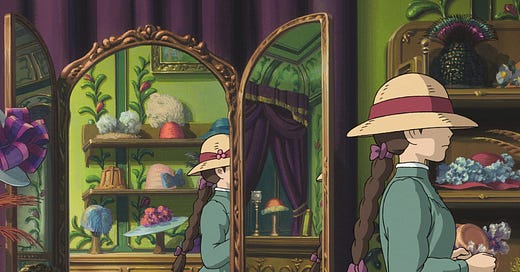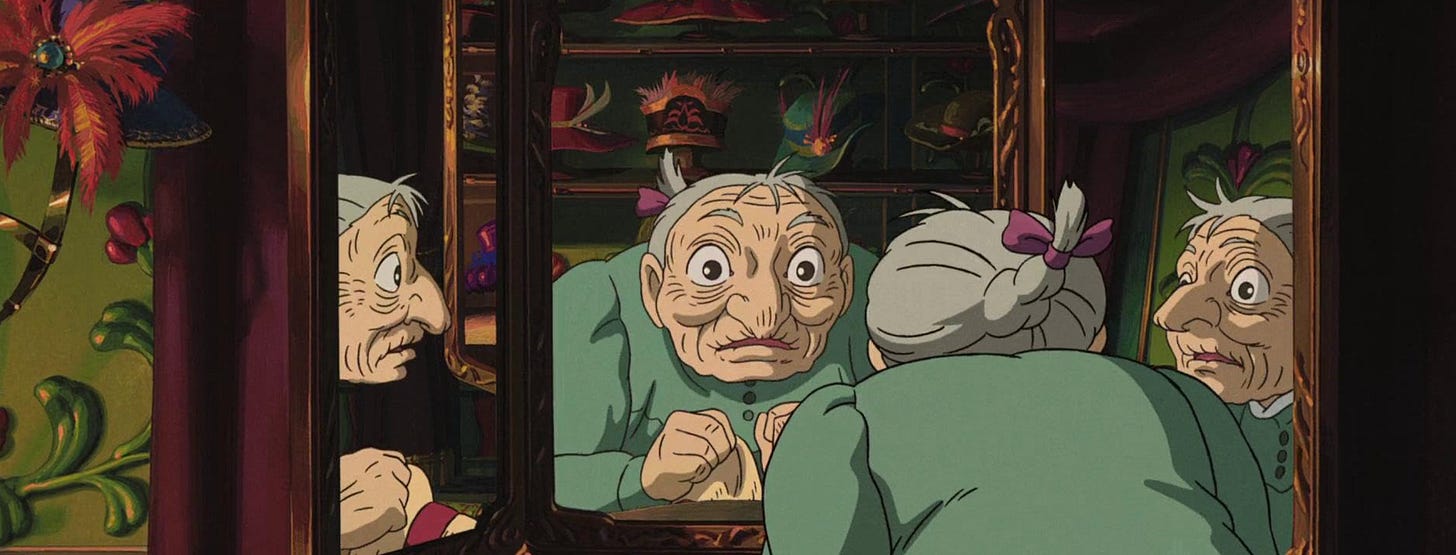Howl’s Moving Castle was my introduction to Studio Ghibli. I was browsing for a film to watch on a crisp morning when I saw it pop up on my recommendation. I decided to watch it, unaware I was about to view a masterpiece. From there, I watched every single Studio Ghibli film I could find. My favourite Studio Ghibli films are From Up on Poppy Hill, The Cat Returns, Spirited Away, Whisper of the Heart and The Wind Rises.
However, I always rewatch Howl’s Moving Castle because of its delicate animation style, entertaining characters and beautiful layers that shine through. Studio Ghibli films seem to have that magical element about them. I’m aware many people analysed this film from different angles with their interpretation. After reading Howl’s Moving Castle by Diana Wynne Jones, the theme of self and love seemed to be a clear aspect of it. It made me rethink how we view beauty and appearances in ourselves and others.
Throughout Howl’s Moving Castle, Sophie continuously struggles to grasp the concept of beauty. From the beginning, it is clear that Sophie is a loner. I found it intriguing that Sophie convinced herself she wasn’t pretty compared to other people her age. She also believed that her being a “home person” is why she is so lonely. Sophie thinks that nobody wants to be friends with an ugly girl so she hides from others or at least that is the idea that Sophie carries with herself. This aspect makes the film’s plot very interesting, especially when the Witch of the Waste gets involved.
When Sophie gets cursed by the Witch of the Waste, her youth is taken away, transforming her into an elderly woman. However, this scene is fascinating because of the reason why the Witch of the Waste cursed Sophie. After all, she is so beautiful—at least in the eyes of the Witch of the Waste since she was jealous. Sophie became a target because the Witch of the Waste heard a rumour that Sophie was the sweetheart of a Wizard called Howl. In the book series, it is revealed that Howl and the Witch of the Waste used to date. Even though this rumour was not true, it didn’t matter since the Witch of the Waste believed that Howl loved Sophie because of her beauty, so in a fit of resentment and anger, the Witch stole Sophie’s beauty by taking away her youth.
Up to that point in the film, Sophie was living in a small town as a hatmaker. However, as soon as she becomes an old woman, she abandons her town, leaving everything and everyone she has ever known. Instead, she chooses to be an aimless wanderer in an unhabitated wilderness called the Waste. Sophie leaves civilisation behind because of her new appearance. She believes that ugly people do not have a place in society. I do not support this toxic idea and the film doesn’t either. I think it shows a realistic idea people share in our world, especially in our age of social media.
Sophie’s adventure into self-love contributes to Howl’s journey of self-love.
Howl’s personality has many layers I could analyse. Instead, I want to focus on his obsession with his hair. Howl’s hair colour is an important plot point in the film. In the first half, Howl dyes his hair blonde but his natural colour is black. Howl’s fixation on creating the impression that he is a beautiful blonde wizard symbolises his romantic relationship with Sophie. When Sophie enters Howl’s home as a housekeeper, she messes with his hair products while cleaning the bathroom. As a result, the next time Howl goes to re-dye his hair, he accidentally turns it orange instead of blonde. This accident triggers a mental breakdown in Howl. Not only does the orange hair make him feel ugly but he also nearly loses his desire to live.
Such a drama king.
The sheer power of his sadness magically transforms the orange colour of his hair to its natural black. I interpret the black as representing the shadowy side of his soul that he conceals from the outside world whenever he dyes it blonde. Fortunately, Sophie is there to help Howl through his breakdown and reassure him that his value as a person does not stem from his blonde hair or physical appearance.
Howl experiences a change in his relationship with Sophie and himself as a result of Sophie’s emotional support. It symbolises the point at which Howl starts to develop feelings for Sophie. The way Howl decides to maintain his black hair colour following his breakdown is a symbol of this love. Howl turns down Sophie’s offer to colour his hair blonde. I believe that Howl’s true natural self is symbolised by his black hair. He had been dying his hair blonde to conceal this true self from the public until now.
Howl had always worried that no one would embrace the truth about him. Still, when Sophie eventually saw Howl at his most vulnerable during his mental breakdown, the outcome was completely the reverse of what he had anticipated. Sophie loved and looked after his scared, childlike self. It was the inner Howl that was concealed beneath the lovely blonde persona. This aspect elicited Sophie’s compassion. Howl had been running from the world for a long time, and it was a deep psychic need that was satisfied to have that self suddenly seen and loved by Sophie.
Howl maintained his black hair since that feeling of fulfilment was comforting. Howl kept it black for Sophie’s benefit since he enjoyed revealing his true self to her.
I guess, true love conquers all.
“One thing you can always count on is that hearts change.” — Howl’s Moving Castle







